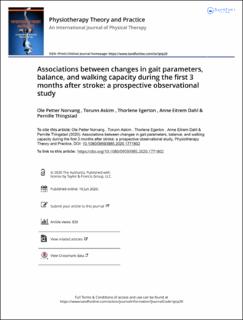| dc.description.abstract | Background: Independent ambulation is a common rehabilitation goal after stroke, requiring adequate balance and efficiency of gait. Spatiotemporal gait parameters are expected to improve in the first 3 months and their association with balance and efficiency of gait may provide useful insights into the recovery of safe and independent mobility. Objective: Examine the associations between changes in spatiotemporal gait parameters, balance, and walking capacity during the first 3 months after stroke. Methods: This prospective observational study included participants diagnosed with stroke. Within the first 2 weeks after stroke onset and again 3 months (±2 weeks) later, gait was assessed using a GAITRite mat at self-selected gait speed, balance using the Berg Balance Scale (BBS), and walking capacity using the 6-minute walk test (6 MWT). Changes in gait parameters, balance, and walking capacity were assessed using paired sample t-tests, and linear regression analyses were used to assess associations between changes in spatiotemporal gait parameters, BBS, and 6MWT. Results: Seventy-nine participants (mean (SD) age 75.4 (8.5) years; 44 men) were included. Gait parameters, balance, and walking capacity all improved during follow-up. The bivariate regression analyses showed associations between improvements in all gait parameters, except walk ratio, with improvement in balance, and in all gait parameters with improvement in walking capacity. Only gait speed was associated with balance (13.8 points, 95% CI 0.5, 27.8, p = .0042) and walking capacity (256 m, 95% CI 173,340, p < .001) in the multivariate analyses. Conclusion: Improved spatiotemporal gait parameters were associated with improved balance and walking capacity within the first 3 months after stroke. | en_US |

